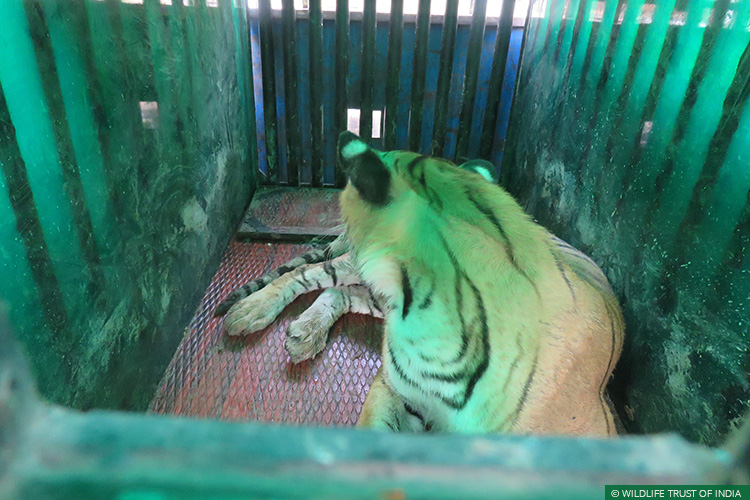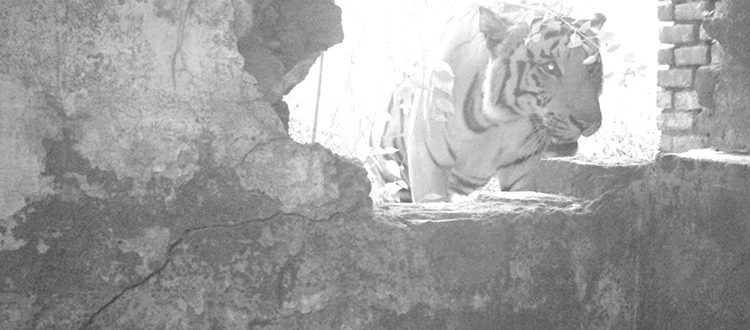WTI and UP Forest Department Rescue Tiger from Abandoned Rubber Factory in Bareilly
[acx_slideshow name=”Terai Tiger Bareilly 04052018″]
Bareilly, Uttar Pradesh, May 04, 2018: A prolonged period of suspense came to an end yesterday afternoon when a young male tiger that had taken refuge inside an abandoned rubber factory in Bareilly was captured by members of Wildlife Trust of India’s (WTI) Rapid Response Team, working in concert with personnel from the Uttar Pradesh Forest Department. The operation had kicked off on April 22 when the first direct tiger sighting had been reported.
As a first step, camera traps were deployed across the premises of the abandoned building to understand the routine, movement patterns and condition of the tiger. The prime concern of Dr PP Singh, Chief Conservator of Forests (Bareilly) and Field Director of Pilibhit Tiger Reserve, was the safety of the tiger as well as the local residents. “We wanted this tiger to be caught in a very scientific manner, so that it didn’t escape from the factory and enter a human habitation, potentially attacking people,” he said.
The Rapid Response Team’s constant monitoring of the factory provided interesting insights into the coexistence of humans and wild animals in a human-dominated landscape. Now home to herds of nilgai and blackbuck, the rubber factory was reportedly once Asia’s largest, until it was abandoned in the 1980s following a legal dispute. The factory premises are a mosaic of water tanks, underground tunnels, warehouses for storing acid and buildings with up to 14 exits, all of which made the task of locating the tiger extremely challenging. WTI’s team kept a vigil on the premises to draw out important details prior to any action. “We wanted to understand the routine of the tiger, the exits and entrances it uses, its habits, the areas where it would rest and finally where it slept. The camera traps also told us of the abundant prey populations in the area. Finally, on May 2, we were able to identify a narrow tunnel where the tiger slept,” said WTI Biologist Francis Ishmael.
The tunnel was located inside a 50×20 foot room with old power panels on the inside perimeter. Yesterday, when the tiger was finally https://youtu.be/kGeBGaMs8G8visible during the day, the team attempted to tranquillise it, which initially proved difficult. “The tiger was wary and slightly agitated due to the presence of humans, which made the operation very challenging. Three doses of darts had to be shot to completely sedate the animal”, said WTI Veterinarian Dr Reetika Maheshwari, who successfully tranquillised the animal at around 2.00pm.
Although injured, the tiger did not attack any human and was surviving on natural prey in and around the rubber factory.
Weighing 172.45kg on an empty stomach and aged around three to four years old, the young male had an injured right foreleg: the second claw had been ripped off and the wound was infected, and a puncture wound between the second and the third digits was also infected. In addition, three claws on its right hind limb were also worn away. “It is possible that the puncture wound is from a metal rod or a porcupine quill”, said Dr Mayukh Chatterjee, who heads WTI’s Human-Wildlife Conflict Mitigation Division. “The area is littered with rusted metal, broken asbestos, rods and chemicals, all of which could be potential causes for the tiger’s injuries.”
Given its injuries, the tiger’s immediate release back into the wild could not be recommended, and it was decided that the animal would be moved to Kanpur zoo for further assessment. “Although injured, the tiger did not attack any human and was surviving on natural prey in and around the rubber factory. Such cases outline the behaviour of these elusive big cats who try to avoid encounters with humans as far as possible” said Dr Chatterjee.
WTI operates two Rapid Response Teams and a long-term project, the Terai Tiger Project (with support from the Uttar Pradesh Forest Department and the US Fish and Wildlife Service), to mitigate conflict between humans and big cats in the Dudhwa-Pilibhit landscape. Since 2009, the project team has rescued nine tigers from 37 human-tiger conflict situations, with four tigers successfully released back into the wild.










